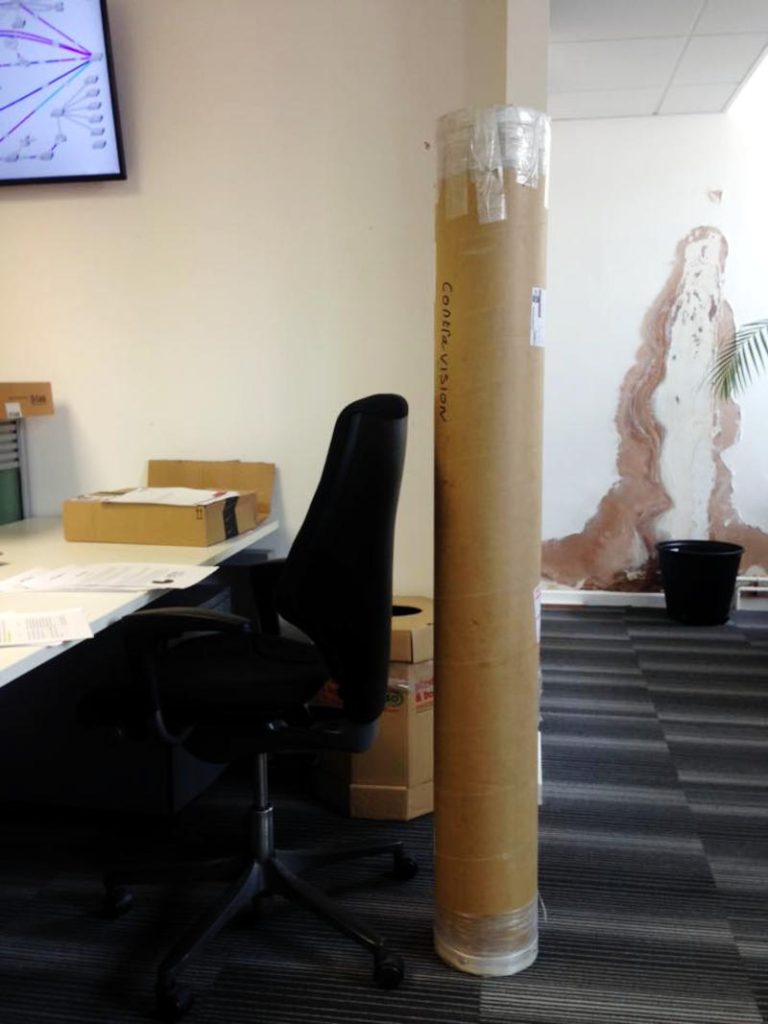The following article was written by Lewis Shaw of Braincrack Games.
Hi! My name is Lewis Shaw and I run Braincrack Games, a UK-based tabletop games publisher that’s been bouncing around the scene since 2016.
After my recent interview with Heavy Cardboard and a post on our own blog where I listed some of the reasons I don’t think people should rush to start their own board game publishers, Oliver was kind enough to invite me to guest post on Tabletop Games Blog and talk more about the challenges the industry has thrown us in recent years – a brave choice, considering I could easily clear a room this way!
So today I’ll be going over a few of the issues that we encounter between a successful Kickstarter and successful fulfilment and how we’ve managed to overcome these – so far, at least!
For the most part, the ‘business as usual’ challenges that we have always faced can be broken down into three categories: those posed by international communication, those posed by the nature of the market-at-large and those that specifically occur in the production of board games.
To be clear, our business model is to Kickstart and mass-manufacture board games. I say this so that you can understand our goals in a given project and make clear that we know this isn’t the only way of doing things! Changing this business model would obviously solve many problems, but that’s a discussion for another day!
Communication
For most businesses in the tabletop industry, getting your game made relies on working with a factory, usually in another country. The savings made this way can be huge. Lower living costs can mean lower viable wages, which will make up the bulk of your production costs no matter where you produce in the world, enabling you to halve or even quarter your product cost.
But in case this wasn’t obvious, these savings come at a trade-off! Different countries mean different time zones, which can slow things down, creating an over-reliance on email. This can exacerbate already slow processes, like quotation, which is particularly essential when scoping out and planning a project.
Language barriers also play a role, especially posing issues with particularly complex projects like miniatures games or heavy Euro titles with lots of parts, requirements and player expectations that might not be obvious to someone who hasn’t – and may never – play the game.
At a certain point, the size of your production run may even necessitate a factory visit – and plane tickets don’t get much more expensive than those to the other side of the globe!
Perhaps the issue I personally experience most often, though, is reading between the lines. Manufacturers are, undoubtedly, the experts in their given area with insight that only feet on the ground in the factory itself can grant. But account managers are also, especially in an increasingly competitive industry, sales people.
As we scope out product choices, it’s not uncommon to ask for a price and be told “no, you don’t want that,” or “try this instead!” Particularly frustrating (for everyone involved!) is when factories have adapted to an industry “standard” that we are trying to change or improve upon. A lot of time can be saved by listening to good advice, but the dilemma we face is discerning good advice from good sales rhetoric.
The Market
While the last few years have been a grotesque escalation of these issues, the matter of dealing with “the market” (i.e. the industrial context beyond our silly little board games) has always posed its own challenges.
Just like communication, many of these are issues that only arise from the almost-irresistible appeal of doing business in places like China. A concentration of industrial activity means that part, machine and material availability is frankly incredible. For Florence, our last game, we asked our manufacturer if we would also be able to produce metal jewellery as an accessory for the game and I can’t exaggerate enough how little effort it took for us to get a jewellery designer and sculptor, source coloured gems, and have samples made within a matter of weeks.

But that ease of getting things done only makes it more baffling and frustrating when things can’t be found or you’re told there is not a pre-existing tool for a part that you’re sure you’ve seen in a ton of board games already. Who knew – being spoilt for choice can make you spoiled!
The biggest issue the market throws at us, though, is price fluctuations. Planning a game with a year or more of development, months of pre-production, a Kickstarter campaign that demands exacting pre-visualisation of the finished product and then another half a year of manufacturing lead time, is difficult at the best of times – least of all when you want to end up with a modest profit at the end!
From material availability and price, to the cost of shipping containers and the actual service of freight itself from the factory to your intended distribution centres in each region, the rising and falling of these prices can break or make any prospect of profit on a mass-manufactured board game project – and in some edge cases, the prospect of it completing at all!
Production
Then there comes the issue of actually making the game – an immensely complex process involving DTP graphics, an understanding of mass manufacturing procedures, sampling, assembly, trouble-shooting, moisture control, shipping terms and regional product quality standards.
At this point, I will lay down a whopping-great disclaimer: while we built our business ourselves, from home, without any initial personal investment, I have the privilege of a degree and years of industry experience in publishing and a lot of what we’re able to do at Braincrack – and able to do with the money we have – is down to this. This is not me trying to brag, by any means, more to set realistic expectations for anyone looking to join the industry: we struggle, even with the advantages we have!
With that in mind, what can go wrong while making a board game?
Many issues stem from the plan and process itself – with processes changing from factory to factory, knowing what to expect, what to check for and what boxes to tick can be difficult, especially when starting out. Add to this the varying challenges and requirements for each individual project and things can quickly become too much for one head to manage!
Take for example the matter of sampling. Sampling is how we go from a black and white quote sheet to a finished product and the process can vary wildly in length. You want to answer questions that have hitherto only been answered with guesswork and the factory wants to go from quotation to finished sale with as little expense as possible.

Blank samples consist of a full unprinted copy of the game, to help you assess material quality, weight, dimensions and packing considerations (helping you answer useful questions like “will this actually fit in a box?” and “how much will this cost to post?”) But some factories may omit this step entirely, going straight to a printed sample or only sampling custom elements of the game.
Correcting the errors that are found through sampling is the main, if only, way that we can ensure a quality final product, but when corrections are required and factories want to do as little sampling as possible, lead times can quickly spin out of control, delaying your game by months on end.
In this case, having an experienced, independent or in-house production manager can be a big help – though at no small cost!
Once you’re sure the factory is making the correct thing, there are still plenty of wrinkles, from complicated shipping terms and acronyms that you’re just supposed to understand (there was me thinking F.O.B. was a catchphrase from Thunderbirds) to the matter of cardboard’s tendency to get mouldy and rot or flake if it’s not kept in a perfectly-controlled environment.
Would you like to see today’s specials?
Of course, everything I’ve said so far was true before The Event. So what special treats has the world had for us these past two years?
The most notable, of course, are price hikes to cardboard and freight – and resulting backlogs created by those of us who had the luxury of being able to wait and see if prices would go down after a while.
Shipping was always the most expensive part of making and delivering a Kickstarter board game, so you can imagine the ensuing heart attack we had when we saw prices had gone up by up to 600%.
A global cardboard shortage was a little less expected. I mean, how dare you, Amazon, don’t you know cardboard is our thing?!
What we (as in, as a board game company) absolutely didn’t see coming were planned power outages in the Chinese factories that we rely on. For those of you who were unaware and who don’t mind some slight oversimplification, the issue is/was threefold:
- China’s government strictly controls the price of energy to keep it affordable to everyday people and businesses alike,
- China’s government is also trying to become carbon neutral by 2060, which means reducing coal production, even though they still need lots of coal to meet demand and
- with dwindling coal supplies, the coal plants could either operate at a loss through winter or just shut down occasionally – so they chose the latter.
This meant that to preserve resources, non-essential industry like (controversially) board games were forced to shut down for set periods over the recent months.
Add to this the ‘cherry on top’ of COVID-19 related labour shortages both with our factories and licensing partners and the result is a slightly ridiculous amount of delays that we’ve had to swallow and pass onto our ever-patient Kickstarter backers.
How we handle it
So how have we managed to keep our Kickstarter backers from kicking down our door and burning us at the stake, so hungry as they are for their luxurious stretch-goal-laden pledge of Florence?
It’s simple. Are you ready? We are honest with our backers!
It’s an obvious answer, yes, but you’d be surprised how many publishers fail to follow this advice. The results speak for themselves, though. Not only are our backers polite and patient (with exceptions, you know who you are), but when we nervously explained the rising costs to them last year, our backers actually volunteered to pay more of the difference than we asked, to help us stay in business.
Because yes, anyone who’s spent more than five minutes on Kickstarter will know that people can be incredibly rude sometimes. But that is usually only the case when legitimate questions or concerns have been met with hand-waving, updates about “look at the cool art instead”, lies or – and this is the worst thing you can do – no updates at all.
Communicate, Plan, Prepare
So there you have it – a whistle-stop tour of all the things that will make you want to faceplant your desk if you want to publish a board game. What can we learn from today’s lesson?
Communicate: Figure out what you want, ask questions and keep it super simple to help make your life and the life of your manufacturer as easy as possible.
Plan: Financial forecasting is nobody’s idea of fun, but having a solid plan for development, production and fulfilment can be a lifesaver. Or so I’ve heard.
Prepare: That is, prepare for things to go wrong anyway! Publishing your own board game is a monumental task and if it were easy, it wouldn’t be an achievement.
Granted, none of this advice is rock solid stuff that’s going to solve all your problems and I wouldn’t blame you if you walked away from this article feeling more intimidated than empowered, but hey, at least I saved you the surprise.
If you like being told how to live your life by strange men on the internet, check out my other article on why you shouldn’t start a board game publisher – and more importantly, what you should do instead!
Also check out Last Resort on Kickstarter if you want to support our latest project!
Written by: Lewis Shaw, Braincrack Games
For behind-the-scenes updates, branded merchandise, and more, please support the blog.
Useful Links
- Braincrack Games: https://www.
braincrackgames. com/ - Heavy Cardboard: https://www.
heavycardboard. com/ - Florence: https://www.
braincrackgames. com/ florence - Florence BGG listing: https://boardgamegeek.
com/ boardgame/ 317411/ florence - 4 reasons to NOT start a publishing company article by Lewis Shaw: https://www.
braincrackgames. com/ braincrack-blog/ 2022/ 1/ 28/ 4-reasons-to-not-start-a-publishing-company- - Last Resort: https://www.
braincrackgames. com/ last-resort - Last Resort Kickstarter page: https://www.
kickstarter. com/ projects/ braincrack-games/ last-resort
Audio Version
Intro Music: Bomber (Sting) by Riot (https://www.


